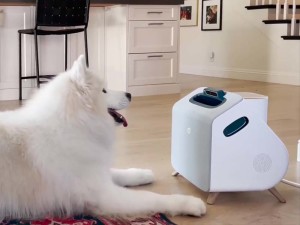New AI Technology Can Help Decode Dog Barks
The tech may help us better understand our pups.

Share Article
No one likes being misunderstood — including your pup. And while they might bark, whine, howl, and yip their little hearts out, at the end of the day, they don’t speak your language (without buttons, anyway) — which leaves a lot of room for human error.
Studies have found that people really aren’t all that great at understanding their pup’s body language and vocalization habits, especially when it comes to aggressionopens in a new tab. But modern tech might offer a solution. New researchopens in a new tab from the University of Michigan (U-M) is using artificial intelligence to decode different kinds of dog barks, which could do wonders for helping us understand our canine friends.
How AI is decoding dog barks
An early challenge in building the new AI model was that, unlike human speech, there is not much data on dog barks available publicly. “Animal vocalizations are logistically much harder to solicit and record,” Artem Abzaliev, a U-M doctoral student and the lead author of the study, told University of Michigan Newsopens in a new tab. “They must be passively recorded in the wild or, in the case of domestic pets, with the permission of owners.”

Get (totally free) deals for food, treats, accessories, tech, and way more pet parenting must-haves.
opens in a new tabSo, instead of starting from scratch, the researchers turned to existing AI models that were originally designed to analyze human speech patterns; there are many of these models, thanks to programs like language translation and voice-to-text. “These models are trained to distinguish nuances in human speech, like tone, pitch, and accent, and convert this information into a format that a computer can use to identify what words are being said, recognize the individual speaking, and more,” reported U-M News.
Using one of these models, Wav2Vec2, they used vocalizations from 74 dogs of various breeds, sex, and ages to train the AI to analyze the tones of different dog sounds. Some of the included contexts were aggressive barking at a stranger, anxious barking, positive squealing, negative squealing, barking during play, and barking in fear of a stranger.
The AI was able to accurately determine the breed, sex, and age of different dogs by listening to the vocalizations. It could also effectively determine the contexts behind the barks, such as whether the sound was playful or aggressive.
“There is so much we don’t yet know about the animals that share this world with us,” said Rada Mihalcea, a U-M professor and the director of U-M’s AI Laboratory. The researchers are hoping that further tech advances can be made to help animal behaviorists, researchers, and pet parents learn how to interpret and respond to the emotional needs of the dogs in their lives.

Sio Hornbuckle
Sio Hornbuckle is a writer living in New York City with their cat, Toni Collette.
Related articles
![Man holds his fluffy white dog outside.]() opens in a new tab
opens in a new tabAI Discovers 5 Different Dog Personalities—Which One Is Your Pup?
A new study says your dog could fall into one of these categories based on their reactions to real-life events.
![A woman laughing while sitting on a bench with her dog.]() opens in a new tab
opens in a new tabWhistle’s New Smart Collar Is Giving Pets a Voice
Your dog can’t tell you if they don’t feel well, but the cutting-edge AI behind this health tracker can.
![dog looking at companion device]() opens in a new tab
opens in a new tabWould You Let A Robot Train Your Dog?
Companion has developed an AI device that might change how we train our pets, whether we’re there for it or not.
![A Young Woman Rests in the Grass With Pet Poodle Dog.]() opens in a new tab
opens in a new tabHere Are the Biggest Pet Trends For 2024
From sustainability to training, here’s what the new year promises to bring.
![a dog photographed by Sophie Gamand]() opens in a new tab
opens in a new tabWhy I Used AI to Reconstruct Cropped Dog Ears
Vets everywhere agree that ear cropping is an unnecessary procedure that can lead to health problems. See how I gave these pups their ears back.
![Jack Russell puppy grunting while laying on blanket and crying out]() opens in a new tab
opens in a new tabListen Up! Your Puppy Is Trying to Talk to You
How to make sense of all those grunts and whines.






